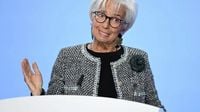The European Central Bank (ECB) is gearing up for one of its most critical monetary policy meetings in recent months, amid escalating economic uncertainty fueled by a trade war initiated by the United States against the rest of the world, particularly Europe. Analysts widely anticipate that the ECB will announce a 25-basis-point cut in interest rates during its meeting on April 17, 2025, a move reminiscent of the 25-point reduction made in March that set the regional interest rate at 2.5%. If market expectations hold, the new rate would drop to 2.25%, further widening the gap with the U.S. Federal Reserve, which currently maintains rates between 4.25% and 4.5%.
The ECB's decisions directly impact financing costs, which are of particular concern for Spanish families. A new rate cut could intensify the pressure on home loan prices, affecting both new mortgages and existing loans tied to the Euribor, the benchmark interest rate for variable-rate mortgages. As of April 15, 2025, the 12-month Euribor fell below 2.2%, settling at 2.167%, marking a continued decline since reaching its peak in September 2022.
Santiago Carbó, director of the financial area at Funcas and an economics professor at the University of Valencia, noted that the recent fluctuations in the Euribor are occurring amid challenging weeks marked by a shift towards trade protectionism. He emphasized that the current macroeconomic environment allows the ECB to act decisively. "The current macroeconomic environment allows the ECB to act swiftly and forcefully. We expect it to make clear that it is prepared to continue adjusting if the situation requires it," stated Gilles Moëc, chief economist at AXA.
Across the Atlantic, the Federal Reserve has also been taking steps to stabilize financial markets. Last Friday, Federal Reserve Bank of Boston President Susan Collins assured that the Fed is "absolutely prepared" to intervene in financial markets if necessary, a message that seemed to calm nerves on Wall Street and in the fixed income markets.
Allianz Global Investors highlighted that fears surrounding the trade war have dampened hopes for a sustained economic recovery in the eurozone in 2025. The optimism that had been generated by fiscal stimulus announced in Germany has quickly faded, replaced by concerns of a potential collapse in demand across the region. In addition, the euro has been experiencing a rally against the dollar, currently trading at 1.12 dollars, which could alleviate inflationary pressures on the eurozone. However, a strong euro also poses challenges, as it can hinder the region's export capacity, particularly in a critical trading environment.
As the ECB prepares for its meeting, expectations are rising that it may consider further rate cuts once the rate reaches 2%. In the meantime, the mortgage landscape appears to be improving, with lower costs providing relief to homeowners and encouraging more households to take on debt under favorable conditions. According to the latest data from the National Statistics Institute (INE), the average interest rate for newly contracted mortgages fell to 3% in January, representing a significant decrease.
On April 16, 2025, the Euribor monthly average dropped to 2.18%, a day before the pivotal ECB interest rate decision. The indicator, crucial for many mortgages in Spain, is responding to the tariff war initiated by former President Donald Trump, resulting in discounts for those renewing their loans. The current Euribor rate stands at 2.132%, which is good news for homeowners needing to renew their mortgages this month, with potential savings exceeding 2,000 euros annually in some cases.
For instance, a 30-year mortgage of 300,000 euros with a 0.99% spread would see monthly payments decrease from 1,467 euros in April 2024, when the Euribor was at 3.703%, to 1,305 euros. This translates to a monthly savings of 162 euros, or 1,949 euros annually. For a smaller mortgage of 150,000 euros, the reduction amounts to 81 euros per month and 974 euros per year.
Even for semi-annual mortgage renewals, the savings are significant. A 150,000-euro mortgage would save 38 euros monthly and 229 euros annually. If the mortgage amount is doubled, the savings increase to 76 euros per month and 459 euros annually.
However, the situation remains complex. Helpmycash points out that the landscape for prospective borrowers has shifted dramatically since the start of 2025, following Trump's announcement of tariffs affecting numerous countries, particularly those in the European Union. Analyst Miquel Riera warns that if the eurozone economy stagnates or enters a recession, the ECB might react by implementing more aggressive rate cuts to stimulate consumption. This would make borrowing cheaper for individuals, businesses, and governments.
Yet, there is also a cautionary note. Should inflation rise significantly above the ECB's target of 2%, the central bank may be forced to freeze interest rates to contain it or even raise them slightly. Riera cautions that this would be detrimental for potential homebuyers, as higher rates would lead to increased mortgage costs and a rise in the Euribor.
The Euribor plays a crucial role in determining interest rates for variable-rate mortgages, and to a lesser extent, mixed-rate mortgages. Homeowners have faced monthly increases of up to 600 euros in some cases when the Euribor peaked. Understanding how the Euribor functions is essential, as it represents the average interest rate at which credit institutions in the eurozone lend money to each other. Introduced in 1999, it serves as the reference rate for most mortgages in Spain.
As the ECB's meeting approaches, all eyes will be on the decisions made in Frankfurt, with potential implications for millions of homeowners across Europe.


